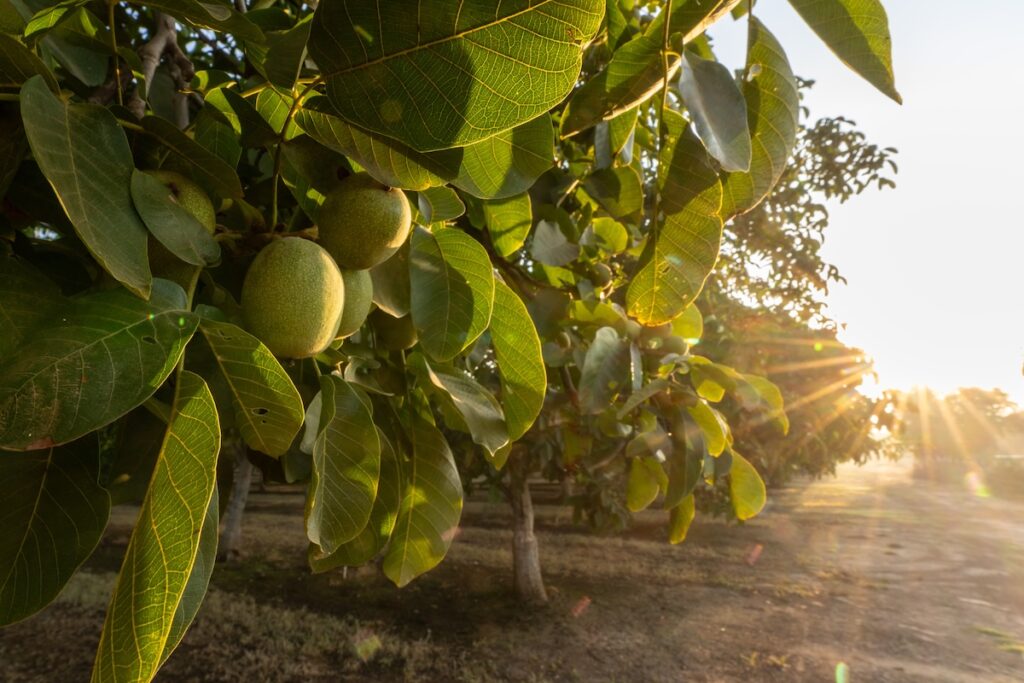
September/October 2025
California walnut industry outlook
As the California walnut industry prepares for the 2025-26 crop year, growing conditions have been positive with adequate winter chill, a mild spring and cooler-than-average summer temperatures.
Early estimates suggest a slightly larger crop than last year, and walnut quality — a key focus of the industry’s strategic plan created in 2023 — is projected to be strong. Coupled with moderate carry-in inventory and substantive industry progress in a range of areas, there is a promising season ahead with short- and long-term growth opportunities globally and at home.
 Global consumption of walnuts is on the rise, and export markets remain critical to the industry’s success. The California Walnut Board (CWB) and California Walnut Commission (CWC) are focused on opening new markets and maximizing market share both domestically and abroad. The CWC participates in programs including the USDA’s Market Access Program (MAP) and Regional Agricultural Promotion Program (RAPP), which enable industry efforts to develop and enhance market opportunities for California walnuts in key international markets.
Global consumption of walnuts is on the rise, and export markets remain critical to the industry’s success. The California Walnut Board (CWB) and California Walnut Commission (CWC) are focused on opening new markets and maximizing market share both domestically and abroad. The CWC participates in programs including the USDA’s Market Access Program (MAP) and Regional Agricultural Promotion Program (RAPP), which enable industry efforts to develop and enhance market opportunities for California walnuts in key international markets.
Global opportunities fuel growth
Asia, Europe and the Middle East continue to bring opportunities, although trade policy significantly influences market dynamics.
India represents one of the most significant growth opportunities, with some estimates showing annual demand could grow significantly with improved market access. In 2018, India issued a 100% tariff on all walnuts, and there is tremendous opportunity to increase shipments if the tariff was reduced. In the current season, India will import approximately 16,000 tons of California walnuts.
Elsewhere, demand in South Korea, Japan and the European Union has remained steady. As of early August 2025, the EU maintains tariffs at 4% on in-shell walnuts and 5.1% on shelled walnuts, though these policies remain under review.
Throughout the globe, the CWC continues to seek expanded market access and ensure long-term competitiveness for the industry. Utilizing USDA programs such as MAP and RAPP, the CWC implements consumer and trade development marketing programs in over 20 countries. However, opportunity exists not only internationally but also in our own backyard.
Expanding domestic markets
Roughly 35% of California walnuts are consumed domestically. The CWB and CWC, serving as champions for the industry, are working hard to increase domestic consumption and value through more robust marketing efforts aimed at introducing California walnuts to a new, younger consumer through relatable, lifestyle-based messaging while continuing to appeal to those who already know and love California walnuts.
At the crux of these direct-to-consumer efforts is a focus on positioning California walnuts as a “feel-good” food, packed with nutrition and perfect to elevate snacks, salads, meals and plant-based applications. Consumer marketing is supported through concentrated strategies in retail, food service and food manufacturing.
In retail, the focus is on sales promotions of California walnuts outside the baking aisle and expanding displays and co-marketing promotions in the fresh produce section and snacking aisles. In food service, walnuts are being positioned as a versatile ingredient aligned with modern culinary trends. The CWB and CWC are providing culinary training and marketing support to place more walnuts on menus for restaurants and food service operations. And in food manufacturing, the focus is on helping manufacturers innovate and commercialize new products using the unique properties of California walnuts.
All of these channels serve as means of amplifying a strong health messaging platform, supported by more than 200 peer-reviewed studies and ongoing research about the health benefits of walnuts.
Investing in research and sustainability
Beyond marketing, the industry recently completed an industrywide survey to capture the sustainability practices widely adopted by growers and identify areas where additional resources could enhance these efforts. In addition, the CWB and CWC are revamping their crop production and postharvest research processes to ensure all research is industry driven. This includes focusing on goals such as improved quality, new variety development, new sustainable plant protection initiatives and activities that increase efficiencies and allow the industry to thrive long-term.
A shared vision for the future
With harvest expected to begin in mid- to late September, there is much to be excited about — but also more work to be done. The CWB and CWC staff and boards of directors are committed to collaborating with the California walnut community to drive grower prosperity. We believe some of the best ways to do this are by embracing a consumer mindset, building on existing opportunities, seeking solutions to challenges and continuously improving.
In 2023, the industry identified a bold vision where consumers around the globe crave California walnuts. Making this a reality depends on continued coordination among growers, handlers and industry members.









